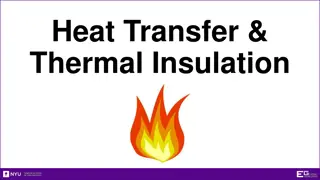Understanding Heat Transfer: Conduction, Convection, and Radiation
Heat transfer is a fundamental process that occurs through conduction, convection, and radiation. Conduction involves the transfer of heat between particles through direct contact, while convection moves heat within fluids and gases through currents. Radiation is heat transfer through electromagnetic waves. This explanation explores how heat is transferred and why certain materials feel colder or warmer than others at the same temperature.
Download Presentation

Please find below an Image/Link to download the presentation.
The content on the website is provided AS IS for your information and personal use only. It may not be sold, licensed, or shared on other websites without obtaining consent from the author. Download presentation by click this link. If you encounter any issues during the download, it is possible that the publisher has removed the file from their server.
E N D
Presentation Transcript
FLUID MECHANICS and HEAT TRANSFER (FMHT) L. E. College, Morbi-2 Industrial Engineering Department Chapter-07 Conduction Prepared by Prof. Divyesh B. Patel Mechanical Engg. Dept LE. College, Morbi +919925282644 divyesh21dragon@gmail.com
Heat Transfer Heat always moves from a hot (warmer) place to a cold (cooler) place. Hot objects in a cooler room will cool to room temperature. Cold objects in a warmer room will heat up to room temperature.
Question If a cup of coffee and a ice were left on the table in the room what would happen to them? Why? The cup of coffee will cool until it reaches room temperature. The ice will melt and then the water will warm to room temperature.
How is Heat Transferred? There are THREE ways heat can move. Conduction Convection Radiation
Conduction Heat is transferred from one particle of matter to another in an object without the movement of the object. Conduction = CONTACT
Conduction When you heat a metal strip at one end, the heat travels to the other end. As you heat the metal, the particles vibrate, these vibrations make the adjacent particles vibrate, and so on and so on, the vibrations are passed along the metal and so is the heat. We call this? Conduction
Why does metal feel colder than wood, if they are both at the same temperature? Metal is a conductor, wood is an insulator. Metal conducts the heat away from your hands. Wood does not conduct the heat away from your hands as well as the metal, so the wood feels warmer than the metal.
Convection Convection is the movement that transfers heat within fluids and air (gas) Heat is transferred by currents within the fluid or gas Convection = VENTS (through air and liquid particles) Convection moves in a circular pattern
Convection What happens to the particles in a liquid or a gas when you heat them? The particles spread out and become less dense. This effects fluid movement. What is a fluid? A liquid or gas.
RADIATION Radiation is the transfer of energy by electromagnetic waves Radiation does NOT require matter to transfer thermal energy Radiation = Radiates (heat escaping the sun)
Radiation May Come From Other Sources Have you ever sat too close to a campfire while cooking marshmallows? You re enjoying the warmth .. only to notice that your skin is really warm?
Examples of RADIATION 1. Fire 2. Heat Lamps 3. Sun























